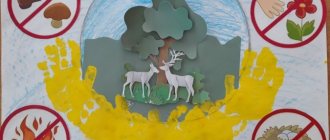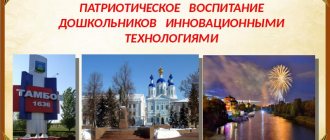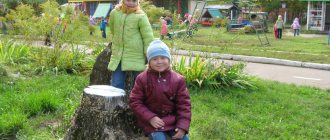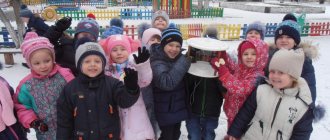Middle group. Junior preschool age. Children 4 - 5 years old
Environmental social and educational project in the middle group (from 4 to 5 years old) “Eco-preschool children” Relevance of the Project One of the directions for the development of the state and the unification of a multinational society is the patriotic education of the younger generation. This is one of the priority areas in the Russian education system, contributing to the formation of...
Environmental project in the middle group “We are young defenders of nature” Environmental project in the middle group : “We are young defenders of nature ”
Project manager : Prokopyeva Lyubov Ilyinichna. Project duration : short-term (1 month)
Project type : educational and research Project : children, middle school teacher, parents….
Environmental project in the middle group “The world through the eyes of children”
author: Boldyreva Svetlana Aleksandrovna
Teacher, Samara MBDOU "Kindergarten 452 "Businka"
Environmental project in the middle group “The world through the eyes of children”
Environmental project in secondary group No. 4 “Chamomile” “The world through the eyes of children”
Educator: Boldyreva Svetlana Aleksandrovna MBDOU No. 452
PROJECT
on environmental education of middle group children
"The world of animals through the eyes of children"
Explanatory note.
The Year of Ecology has started across Russia. The problem of environmental education of preschool children is becoming particularly acute and relevant. It is during preschool childhood that the beginnings of ecological culture are formed. Therefore, it is very important to awaken in children an interest in living nature, to cultivate a love for it through knowledge of the world around them.
The role of animals in nature is so great that a person could hardly not only get along, but even simply live without them. And the point is not only that animals provide man with food, fur and wool, and serve him with their strength, speed and endurance. There is no doubt that the “Red Book”
Both nature reserves and national natural parks are very necessary for the protection of wildlife. But even more important is the responsibility for nature that every person bears.
Students from our group also actively participated in environmental events. We invited the families of our pupils to participate in the project “The World of Animals through the Eyes of Children”.
The project will take place in 4 stages:
- “Animals through the eyes of children” (drawings of animals of the Krasnodar region)
; - Exhibition on the theme “Animal diversity” (crafts and needlework)
; - “Sea inhabitants” (drawings of the inhabitants of the Black Sea)
; - Tabletop mini-presentations “My Pet” (photo collages, folding albums about pets)
.
Children can display their desire to protect nature in their creative works.
The best works will take part in the design of a kindergarten gift calendar.
Project goal: to create conditions for the development of children’s cognitive and creative abilities in the process of developing a child-adult educational project “The Animal World through the Eyes of Children”
in pupils of middle preschool age.
In accordance with the goal, the following project objectives were formulated:
- Enriching and deepening children's understanding of the animals of their native land, their diversity and living conditions.
- To develop knowledge about the interconnection of all living things in nature, to promote awareness of the special relationship of people to animals and to nature in general.
- Analyze educational and methodological literature on environmental education of middle-aged children;
- Enrich and consolidate the knowledge and ideas of preschoolers about animals living in our forests.
- Teach children to have a kind attitude towards animals.
- Supplement didactic material on environmental education of middle-aged children;
- Develop a system of games that ensure the consistent development of children in the context of play activities;
- Develop information sheets for parents with recommendations for familiarization with this topic.
- Enrich children's vocabulary with names of signs and actions by designating qualities (features of appearance, nutrition, habits)
. - Introduce children to the concept of “Red Book”
. - To develop children's coherent speech through writing a descriptive story about animals and retelling a literary text.
The novelty of the project will be the use of information and communication technologies that help improve the quality, accessibility and effectiveness of environmental education for children. This will make it possible to form elements of logical thinking and develop the intellectual abilities of children, without violating the laws and stages of mental and physiological development, and also taking into account the individual characteristics of children, which makes teaching children interesting, meaningful, and unobtrusive.
Implementation period: long-term, January 2021. – August 2022
Type of project: educational - gaming.
Project participants: middle school students, parents, teacher.
By number of participants: collective.
Form of organization of children: group, subgroup and individual.
Basic principles of project implementation:
— Accessibility (correspondence of the didactic task to the age and individual capabilities of children);
— Repeatability (consolidating and complicating the same game)
;
— The relevance of didactic material (up-to-date formulations of environmental problems, visual aids, etc.) actually helps children perceive tasks as a game, feel interested in getting the right result, and strive for the best possible solution;
— Collectivity (allows you to unite the children's team into a single group, into a single organism capable of solving problems of a higher level than those available to one child, and often more complex);
— Competitiveness (creates in a child or a subgroup the desire to complete a task faster and better than competitors, which allows reducing the time to complete the task on the one hand, and achieving a truly acceptable result on the other);
— An element of novelty (the introduction of new attributes, schemes, samples, the possibility of creativity, changing the rules).
Working hypothesis - it is assumed that organized work on environmental education of preschool children in accordance with modern requirements will help to increase the level of development of children's cognitive abilities.
Project implementation stages:
- Preparatory.
At this stage the following activities were carried out:
Studying the level of knowledge on the topic;
Monitoring diagnostics of children;
Drawing up a work plan for project implementation;
Creation of a subject-developing environment on the topic of the project;
Selection of teaching materials, illustrations, photographs, poems, presentations, didactic games, audio and video recordings on this topic;
Preparation of consultations, messages and teaching aids for parents;
Interaction with parents:
- Joint production of didactic games “Where is whose house?”
,
“Whose baby?”
and etc. ; - Assistance in the creation and design of an exhibition on the topic: “Diversity of animals” (crafts and needlework)
; - Tabletop mini-presentations “My Pet” (photo collages, folding albums about pets)
.
Analysis and generalization of existing work experience on this topic in preschool educational institutions;
Studying the experience of other educational institutions.
- Basic.
At this stage, practical work is carried out in order to obtain a high-quality result of this project. Namely:
Conversations with children, solving riddles;
Examination of illustrations, postcards, books on the topic;
View presentations on the topic;
Familiarity with objects in the immediate environment;
Reading fiction and memorizing rhymes;
Children reading poems;
Conducting didactic, plot-role-playing, movement, tabletop and finger games;
Theatrical activities;
Exhibitions of children's drawings “Animals through the eyes of children”
and
"Sea Life"
;
Dramatization “How the animals became friends”
;
Consultations for parents on the topic: “Environmental education of middle-aged children”
.
Creative and productive activities: modeling, drawing, appliqué (joint work of children with parents, independent activity of children;
Watching animated films about animals.
Listening to music.
Business game with parents: “How to understand the world of ecology?”
. Conducting consultations, developing recommendations and manuals for parents.
- Final.
- Positive dynamics of monitoring on environmental education of children of middle preschool age;
- Exhibition of joint creativity between children and parents;
- Creation of a gift calendar “The world of animals through the eyes of children”
, together with parents.
Expected result:
The project will contribute to the development of children’s cognitive and creative abilities, clarify and consolidate ideas about wild animals, habitats and food. The various situations and games used in this project will generate interest, curiosity, and attention in students.
Parents will receive methodological recommendations on creating conditions for conducting didactic games, advice on purchasing and making didactic games, since with the help of games and manuals, preschool children will unnoticed enter the world of ecology. Exciting games will help make the educational process not difficult or boring, but interesting and entertaining!
By implementing this project, we will try to help each child expand their horizons in their immediate environment, as well as create conditions for the development of independent cognitive activity. This project will provide each child with the opportunity not only to gain knowledge, but also to develop creative abilities, develop communication skills, and form the initial prerequisites for research activities. In turn, parents will develop an interest in the educational process, the development of creativity, knowledge and skills in children, a desire to communicate with teachers, and participate in the life of the group.
Bibliography:
- FROM BIRTH TO SCHOOL. Approximate basic general education program for preschool education / Ed. N. E. Veraksy, T. S. Komarova, M. A. Vasilyeva. – 3rd ed., rev. And additional – M.: MOSAIKA – SYNTHESIS, 2012;
- Federal State Educational Standards for Preliminary Education: implementation practice. – M.: Publishing house “Teacher”
, 2014. - Bashaeva T.V. Development of perception in children. Shape, color, sound. — Yaroslavl: Development Academy, 2007;
- Dybina O. V. The child and the world around him. Program and methodological recommendations. – M.: MOSAIKA – SYNTHESIS, 2010;
- Evdokimova E. S. Pedagogical support for families in raising a preschooler. – M.: TC Sfera, 2008.
- Lykova I. A. Visual activities in kindergarten. Middle group. – M.: “Color World”
, 2012. - Mikhalevskaya I. A., Masterkova E. A. A large reader for preschoolers. – M.: My World, 2008.
- Oberemok S. M. Project method in preschool education: Educational manual. – Novosibirsk: NIPKiPRO, 2007.
- Solomennikova O. A. Environmental education in kindergarten. Program and methodological recommendations. – 3rd ed., rev. and additional – M.: MOSAIKA – SYNTHESIS, 2009;
- Pilyugina V. A. Baby’s sensory abilities: Games to develop the perception of color, shape, size in young children. – M.: enlightenment. JSC "Ucheb.
met" 1996; - Collection of Russian folk tales. Ed. R. Kobzareva. – M.: Publishing house “Altey”
, 2012. - Soboleva A.V., Riddles - savvy. Practical guide for speech therapists, educators and parents - M.: “Publishing house GNOM and D”, 2000
Environmental project in the middle group “The world through the eyes of children”
The relevance of the development and implementation of a pedagogical project
From birth, children are surrounded by various phenomena of inanimate nature: on a summer day they see the sun and feel the warm wind; on a winter evening they look in surprise at the moon, the dark sky filled with stars, feel the frost pinching their cheeks... They collect stones, draw on the asphalt with chalk, play with sand and water - objects and phenomena of inanimate nature are part of their life activity, are objects of observation and play. This circumstance makes it possible to systematically and purposefully familiarize preschoolers with the phenomena of inanimate nature. Moreover, it is simply necessary.
In nature, everything is interconnected: plants, animals, soil, rivers, air, etc. are in inextricable unity - living nature cannot do without inanimate nature. The plant exists only because it penetrates the ground with its roots and absorbs moisture and nutrients from it, stretches its stem upward, and turns its leaves toward the sun, absorbing its light and heat. The plant needs air, moisture and warmth; in such favorable conditions it feels good: it grows, blooms, bears fruit and pleases the human eye.
The same can be said about animals: they, like plants, have vital needs, many of which can be satisfied only with the help of inanimate nature. Thus, animals, as part of living nature, have their own special relationships with inanimate nature.
Humans have an even stronger connection with inanimate nature than plants and animals. People need fresh air, for life and farming they need water, but not any water, only clean water - natural or specially purified. Humanity has reached such heights in the development of civilization because it has learned to use natural resources: extract coal, oil, ore, use clay and sand in construction, making household items...
Thus, all phenomena of inanimate nature that surround a preschooler are the subject of a unified system of environmental education.
Understanding the importance of search activity in the development of children’s cognitive activity and their intellectual abilities, I chose children’s experimentation as one of the types of activity. The proverb says: “Tell me and I’ll forget, show me and I’ll remember, let me try and I’ll understand.” Everything is assimilated firmly and for a long time when the child hears, sees and does it himself. This is the basis for the active introduction of children's experimentation into the practice of preschool institutions.
Plan for working with children
September
Project development. Selection of method, literature.
October
Topic: “What kind of water?”
Purpose: To identify the properties of water: transparent, odorless, flows, some substances dissolve in it, has weight, has no color and odor.
Expected result : Children will learn the properties of water such as: transparent, flowing, is a solvent, has no color and odor, and has weight.
Topic: What's in the package?
Goal: Detect air in the surrounding space.
Expected result : Children learn that air occupies all the surrounding space.
November
Topic : Light - heavy.
Purpose: to introduce that objects can be light and heavy. Learn to determine the weight of objects and group objects by weight (light - heavy). Expected result : They will learn to determine the weight of objects and group objects by weight (light - heavy).
Topic: We are magicians.
Goal: Identify objects that interact with a magnet. Expected result : They will become familiar with the properties of a magnet and objects that interact with it.
December
Topic: How to warm your hands?
Goal: Identify the conditions under which objects can warm up (friction, movement; heat conservation). Expected result : They will learn to heat objects using friction, movement and identify the conditions for maintaining heat.
January
Topic: Glass, its qualities and properties.
Goal: Recognize objects made of glass; determine its qualities (surface structure, thickness, transparency) and properties (fragility, melting, thermal conductivity).
Expected result : Get acquainted with glass and its properties. Learn to identify its qualities.
February
Topic: Metal, its qualities and properties.
Goal: Recognize objects made of metal, determine its qualitative characteristics (surface structure, color) and properties (thermal conductivity, malleability, metallic luster).
Expected result : Get acquainted with metal and its properties. Learn to identify its qualities.
Topic: Magic mitten.
Goal : Find out the ability of a magnet to attract certain objects. Expected result : consolidate the properties of a magnet and identify with which objects it interacts.
March
Topic: Rubber, its qualities and properties. Goal: To recognize things made from rubber, to determine its qualities (surface structure, thickness) and properties (density, elasticity, elasticity). Expected result : Get acquainted with rubber and its properties. Learn to identify its qualities.
Topic: What do birds use to build their nests?
Purpose: To identify some features of the lifestyle of birds in the spring. Expected result : They will learn some features of the way of life of birds in the spring.
April
Topic: Plastic, its qualities and properties.
Goal: To recognize things made of plastic, to determine its qualities (surface structure, thickness, color) and properties (density, flexibility, melting, thermal conductivity). Expected result : Get acquainted with plastic and its properties. Learn to identify its qualities.
Topic: Water transparency.
Goal: To generalize “clean water is transparent”, “dirty water is opaque”. Expected result : Get acquainted with the property of water “transparency”, learn to identify clear water.
May
Topic: "Paper lumps."
Goal: To introduce children to a new property of paper - rolling. The teacher teaches children to make lumps of paper, and then use them as a collective applique. Expected result : They will become familiar with a new property of paper - rolling. The teacher teaches children to make lumps out of paper, and then from them into a collective applique.
Interaction with parents
Children's consciously correct attitude towards nature is based on its sensory perception, emotional attitude towards it and knowledge of the characteristics of life, growth and development of individual living beings, some biocenoses, knowledge of the adaptive dependencies of the existence of living organisms on environmental factors, relationships within natural communities. Such knowledge in the process of a child’s communication with nature provides him with an understanding of specific situations in the behavior of animals, the state of plants, their correct assessment and adequate response.
One of the conditions for successfully instilling the fundamentals of environmental culture is not only working with children, but also with their families. Environmental education of preschool children can be considered as a process of continuous education of parents, aimed at developing an environmental culture of all family members. Environmental education (enlightenment) of parents is one of the extremely important and at the same time one of the most difficult areas of work of a preschool institution.
Project stages
I Preparatory stage
- The teacher determines the topic, goals and objectives, the content of the project, predicting the result.
- Discussion with parents of the project, clarification of the possibilities, funds necessary for the implementation of the project, determination of the content of the activities of all project participants.
II Main stage of the project implementation
- Implementation of a work plan for all types of activities with children.
- Interaction with parents to solve assigned problems.
- Creation of the club “The Unknown is Nearby”.
- Once a quarter, joint “meetings” of the club (parents and children) are held in the form of entertainment, games, activities, leisure, and consultations.
- Creation of an information space (information stand; design of a folder - moving).
- A selection of works of art and educational games on this topic.
III. The final stage
Diagnostics and summarizing work results.
- summing up the work on the project.
- survey of parents on the topic: “What has your child learned?”
- monitoring the quality of children’s mastery of material.
- open lesson - entertainment for parents “What we learned” (based on the results of the project).
- presentation of the project for teachers of preschool educational institutions, a message from the experience of working on the project.
Future perspective
Develop a project “The Unknown is Nearby” for children in the senior and preparatory groups.
Although the most significant thing in the mental development of a child occurs at the early age stage, it is necessary to purposefully engage in experimental activities at the next stages of the personal formation of children.
Continuing the further development of cognitive and creative activity through the involvement of preschoolers in research work, the teacher prepares children for a very difficult stage in their lives - the school years.
Forms of working with children
Based on conceptual approaches and taking into account the characteristics of children, we have developed and tested a series of developmental activities. The practical significance lies in the use of the developed material in various types and educational areas of children's activities.
The content of the project involves an integrated approach to the development of a child at the emotional, psychophysiological and intellectual levels through familiarity with nature in various types of work with children (for example, observations, work in nature, activities and holidays of an integrated nature, entertainment, experimental activities).
The choice of priority form of work with children depends on seasonality, children’s interest in the proposed activity, their age characteristics, and conditions.
Long-term plan for the club “The Unexplored is Nearby”
October
Parent meeting on the topic : Let's experiment, learn, create!
Contents : Informing parents that the main advantage of the experimentation method is that it gives children real ideas about the various aspects of the object being studied, about its relationships with other objects and with the environment. During the experiment, the child’s memory is enriched, his thought processes are activated, since the need constantly arises to perform operations of analysis and synthesis, comparison and classification, and generalization.
January
Consultation “Development of observation and curiosity of a preschool child through experimental games at home.” Contents: Informing parents on how to properly ensure the full environmental education of a child of middle preschool age. Continue to introduce games to study the properties of objects and inanimate phenomena that will be used by parents at home.
April
Open game-activity “Journey to the Sand Fairy.”




